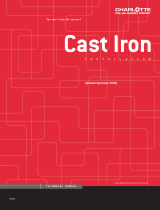
Gasketed Gravity flow Sewer Fitting Installation Guide
Receiving Shipments:
Each shipment shall be inspected with care upon arrival. Each fitting shipment is
carefully loaded at the factory using methods acceptable to the carrier. The carrier is
then responsible for delivering the fittings as received From GPK Products.
Check the materials, gaskets and fittings received against the bill of lading. ANY
DAMAGED OR MISSING ITEMS MUST BE NOTED ON THE DELIVERY RECEIPT
AND RETURNED TO THE TRANSPORTATION COMPANY.
Storage:
Unload shipment not to cause damage to product, store fittings away from any direct
heat sources (engine exhaust, steam lines etc.)
Do not stack heavy objects on top of fittings; this will cause deformation of the fittings.
Do not store in direct sunlight for extended amounts of time.
Gaskets should be covered from UV rays. Gaskets should also be protected from heat,
oil, and grease.
Location of service:
Services should be laid out according to the job plans and specifications.
If field cuts are needed, field cuts should be perpendicular to the axis of the pipe,
smooth and clean from burs.
Field bevels should match factory bevels, typically 15 degrees.
Fitting Inspection/Layout:
Prior to install, if necessary, remove any foreign debris/dirt from pipe and fittings.
Inspected fittings for any defects or damage. Check proper gasket seating and
condition.

Assembly:
Clean the spigot and the bell and gasket
Measure the bell depth of the fitting and mark depth on spigot, different manufactures
have different bell depths, make sure not to over insert the spigot during assembly.
Apply pipe lube that is approved for gravity sewer assembly, don’t not use any
petroleum-based products as these will adversely affect gaskets performance.
Apply lube on the spigot, uniform coat half the length of the spigot, apply even coat of
lube to the gasket.
Push the lubricated spigot end past the gasket into the bell until the insertion line on the
spigot is even with the edge of the bell. DO NOT OVERINSERT.
If you have trouble with assembly, disassemble the joint and examine the gasket. If the
gasket is removable, replace if damaged.
If non-removable gaskets are damaged, you have two options,
1. cut off the bell, bevel the new edge, and use a coupling to assemble.
2. follow GPK’s written instructions on how to replace rieber or mambo gasket.
Be sure that the gasket is properly seated and that the fitting and pipe are in straight
alignment. Repeat assembly steps above. Correct assembly is achieved when the
insertion line on the spigot is lined up with the edge of the bell.
Make sure the fitting and pipe are in straight alignment, also make sure the taper of the
spigot is started over the gasket before apply force to assemble.
The bar-and-block method of joint assembly is recommended, as the installer is able to
feel the amount of force being used and whether the joint goes together smoothly.
Larger pipe may require mechanical assistance to apply sufficient force to assemble the
joint.
When mechanical devices are used, care must be taken to ensure that the spigot is
inserted to the proper depth and that previously assembled joints are not disturbed. This
is accomplished by inserting only to the insertion line on the spigot end. If the spigot is
over-inserted, back the pipe out until the insertion line is visible.
In all cases, straight alignment is essential for proper assembly. If the spigot is
misaligned, over inserted, or assembled with excessive force, the following are possible
consequences:

• rolled gaskets
• failure to pass acceptance testing (e.g., low-pressure air testing and deflection-
mandrel testing)
A bar and block should be used as shown below.
If a pry-bar or backhoe is used for any assembly, a wood plank should be placed
between the pipe and the machine to prevent damage. In addition, the force applied
must be steady and constant. Do not ram or hit the pipe. For all pipe, a come-a-long
jack is recommended over a backhoe. The method of attachment to the pipe must not
abrade or damage the pipe in any way. Steps must be taken during installation using
these methods to maintain correct alignment of the pipe. In addition, a helper should be
present in all cases to assist the operator in knowing when the reference mark is
reached properly.
Inspect:
Once bell and spigot are assembled inspect for proper seat and assembly.
Backfill:
Backfill procedures should follow ASTM D2321 and UNI-Bell guidelines.
Backfill by hand around hard to compact areas and service lines, eliminant any voids
and areas that will cause settlement.
Backfilling should follow fitting assembly as closely as possible. This protects the fittings
from falling rocks, eliminates possibility of lifting the pipe from grade due to flooding of
an open trench, avoids shifting pipe out of line by cave-ins, and in cold weather lessens
the possibility of backfill material’s becoming frozen.
Testing:

Test with low pressure air test, follow ASTM F1417
Installation Tips:
• Backfill and tamp vertical risers in small lifts
• Use ample amount of rock on horizontal runs
• Hand compact around fitting - High stress areas
• Use proven installation techniques and ASTM and Uni-bell guidelines
• Stabilize pipe as much as possible
• Understand the soil conditions and installation practices.
• When rotating a main-line fitting, use the bell on the body for leverage.
• Don’t use the branch of a fitting as a lever to rotate the fitting.
• Use a single length of pipe for the riser section whenever possible.
• Field cut pipe clean and square.
• Follow the fitting manufacturer’s recommended insertion depth.
• Don’t allow heavy equipment to driver over Risers/Laterals
• All connections between pipe and fittings should be made in straight alignment.
• Bending of the riser pipe for grade or angle adjustment should not take place.
• Service laterals and fittings should be installed without angular joint deflections.
• Always follow all local and state codes and requirements
/






